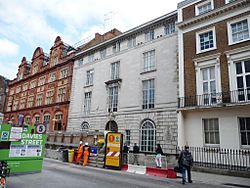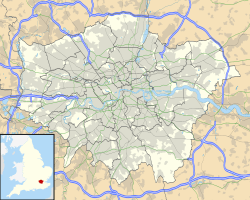Davies Street drill hall facts for kids
Quick facts for kids Davies Street drill hall |
|
|---|---|
| Mayfair, London | |

Davies Street drill hall
|
|
|
Location within London
|
|
| Coordinates | 51°30′48″N 0°08′54″W / 51.51328°N 0.14836°W |
| Type | Drill Hall |
| Site history | |
| Built | 1890 |
| Built for | War Office |
| In use | 1890-Present |
| Garrison information | |
| Occupants | F Company 7th Battalion The Rifles |
The Davies Street drill hall is a historic building in Mayfair, London. For many years, it was a special place where soldiers trained and prepared for their duties. It served as a military base for different army units, helping them get ready for important events, including major wars.
Contents
A Special Building in London
This building, known as a drill hall, was built to be a headquarters for soldiers. A drill hall is a place where military units can gather, train, and store their equipment. It's like a home base for soldiers when they are not on active duty. The Davies Street drill hall has a long and interesting history, showing how military groups in London have changed over time.
Its Early Days
The original drill hall was designed by an architect named Charles Herbert Shoppee. It was finished in December 1890. This new building became the main base for a group called the 1st Middlesex (Victoria and St George's) Volunteer Rifle Corps. A "volunteer rifle corps" was a group of citizens who trained to be soldiers, ready to help defend their country if needed. The Duchess of Westminster officially opened the building.
In 1908, this group joined with another one, the 19th Middlesex (St. Giles's and St. George's, Bloomsbury) Volunteer Rifle Corps. Together, they formed a new unit called the 9th (County of London) Battalion, London Regiment (Queen Victoria's).
Through the World Wars
When World War I began in August 1914, the soldiers from this battalion gathered at the drill hall. They were "mobilised," which means they were called into active service and prepared to go to war. From here, they were sent to the Western Front, a major battle area in Europe.
Years later, in August 1937, the London Regiment was reorganised. The drill hall then became the home of the Queen Victoria's Rifles, part of The King’s Royal Rifle Corps.
During World War II, on November 30, 1940, the building was hit by a bomb. It was badly damaged, but it was decided that it should be rebuilt. The hall was repaired and rebuilt between 1950 and 1952.
Changes Over Time
After the rebuilding, the military units using the drill hall continued to change names and structures. In 1952, the unit based there was renamed the 7th Battalion The King's Royal Rifle Corps (Queen Victoria’s Rifles).
Over the next few decades, this unit evolved several times:
- In 1967, it became the 4th (Volunteer) Battalion, Royal Green Jackets.
- In 1999, it changed to F (Royal Green Jackets) Company, part of the London Regiment.
- In 2006, it became F Company, Royal Rifle Volunteers.
- The following year, it was renamed F Company, 7th Battalion, The Rifles.
Moving On
The Davies Street drill hall served as a military base for a very long time. However, in 2017, F Company moved to a different drill hall on Hammersmith Road. This meant the Davies Street drill hall was no longer used as a military training facility.


